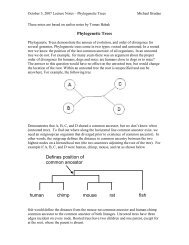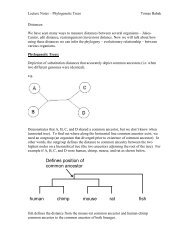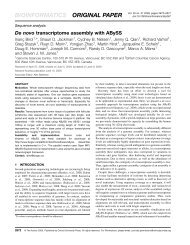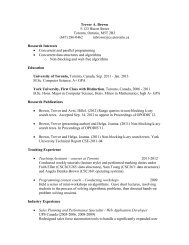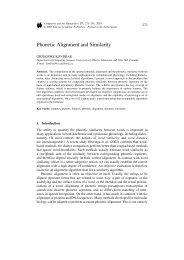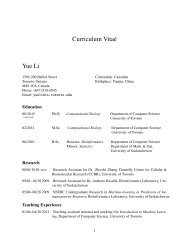CSC 165 H1F Tutorial # 8 Winter 2012 1. Find a tight bound on the ...
CSC 165 H1F Tutorial # 8 Winter 2012 1. Find a tight bound on the ...
CSC 165 H1F Tutorial # 8 Winter 2012 1. Find a tight bound on the ...
You also want an ePaper? Increase the reach of your titles
YUMPU automatically turns print PDFs into web optimized ePapers that Google loves.
<str<strong>on</strong>g>CSC</str<strong>on</strong>g> <str<strong>on</strong>g>165</str<strong>on</strong>g> <str<strong>on</strong>g>H1F</str<strong>on</strong>g> <str<strong>on</strong>g>Tutorial</str<strong>on</strong>g> # 8 <str<strong>on</strong>g>Winter</str<strong>on</strong>g> <str<strong>on</strong>g>2012</str<strong>on</strong>g><br />
<str<strong>on</strong>g>1.</str<strong>on</strong>g> <str<strong>on</strong>g>Find</str<strong>on</strong>g> a <str<strong>on</strong>g>tight</str<strong>on</strong>g> <str<strong>on</strong>g>bound</str<strong>on</strong>g> <strong>on</strong> <strong>the</strong> worst-case running time of <strong>the</strong> following algorithm.<br />
# Prec<strong>on</strong>diti<strong>on</strong>: L is a list that c<strong>on</strong>tains n > 0 real numbers.<br />
<str<strong>on</strong>g>1.</str<strong>on</strong>g> max = 0<br />
2. for i = 0, 1, . . . , n − 1:<br />
3. for j = i, i + 1, . . . , n − 1:<br />
4. sum = 0<br />
5. for k = i, i + 1, . . . , j:<br />
6. sum = sum + L[k]<br />
7. if sum > max:<br />
8. max = sum<br />
Dept. of Computer Science, University of Tor<strong>on</strong>to, St. George Campus Page 1 of 2
<str<strong>on</strong>g>CSC</str<strong>on</strong>g> <str<strong>on</strong>g>165</str<strong>on</strong>g> <str<strong>on</strong>g>H1F</str<strong>on</strong>g> <str<strong>on</strong>g>Tutorial</str<strong>on</strong>g> # 8 <str<strong>on</strong>g>Winter</str<strong>on</strong>g> <str<strong>on</strong>g>2012</str<strong>on</strong>g><br />
2. Prove that TBFT(n) ∈ Θ(n 2 ), where BFT is <strong>the</strong> algorithm below.<br />
BFT(E, n):<br />
<str<strong>on</strong>g>1.</str<strong>on</strong>g> i = n − 1<br />
2. while i > 0:<br />
3. P [i] = −1<br />
4. Q[i] = −1<br />
5. i = i − 1<br />
6. P [0] = n<br />
7. Q[0] = 0<br />
8. t = 0<br />
9. h = 0<br />
10. while h t:<br />
1<str<strong>on</strong>g>1.</str<strong>on</strong>g> i = 0<br />
12. while i < n:<br />
13. if E[Q[h]][i] = 0 and P [i] < 0:<br />
14. P [i] = Q[h]<br />
15. t = t + 1<br />
16. Q[t] = i<br />
17. i = i + 1<br />
18. h = h + 1<br />
(Although this is not directly relevant to <strong>the</strong> questi<strong>on</strong>, this algorithm carries out a breadth-first traversal of<br />
<strong>the</strong> graph <strong>on</strong> n vertices whose adjacency matrix is stored in E.)<br />
Dept. of Computer Science, University of Tor<strong>on</strong>to, St. George Campus Page 2 of 2




